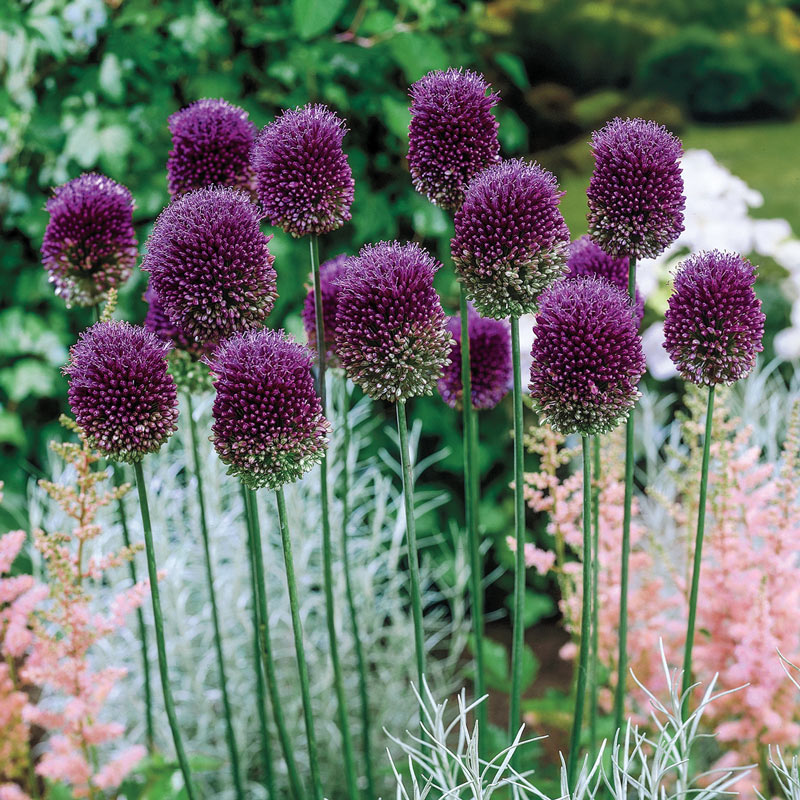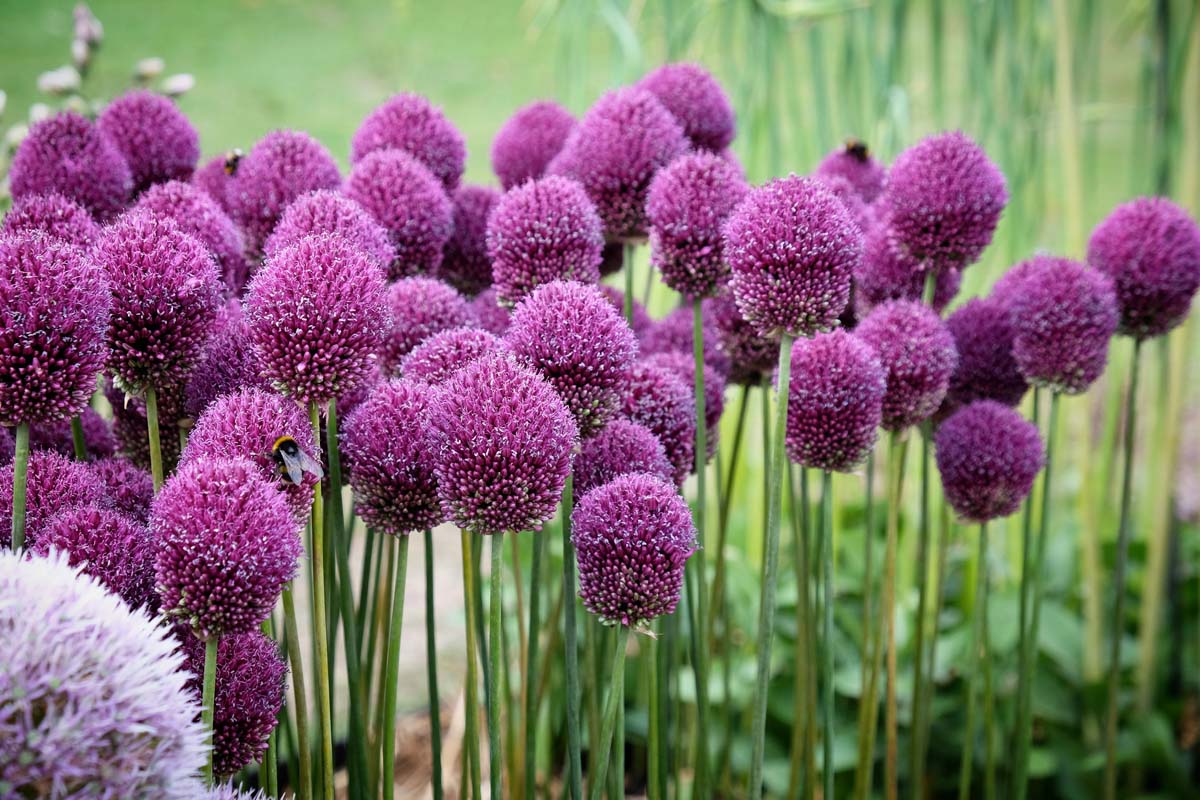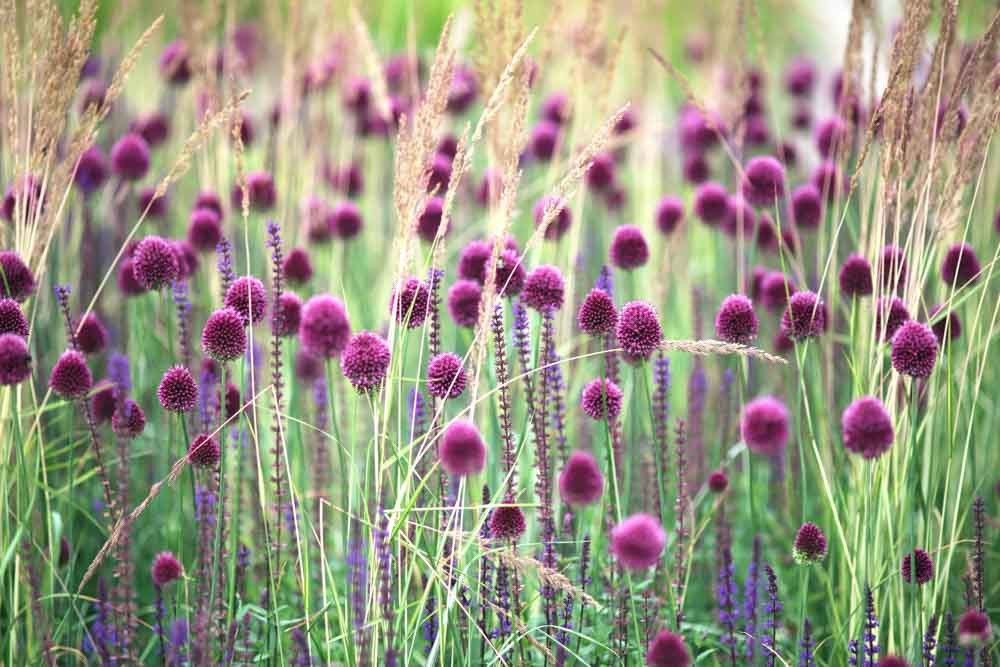Drumstick Allium: The Perfect Companion Plants
Drumstick alliums (Allium sphaerocephalon) are a type of ornamental onion that are known for their distinctive, drumstick-shaped flower heads. These plants are hardy in USDA zones 3-8 and can grow up to 3 feet tall. Drumstick alliums bloom in late spring or early summer, and their flowers can range in color from white to purple to pink.
Drumstick alliums are easy to grow and care for. They prefer full sun and well-drained soil. Once established, they are drought-tolerant and can thrive with minimal watering. Drumstick alliums are also deer-resistant, making them a good choice for gardens in areas with high deer populations.
In addition to their beauty, drumstick alliums also have a number of practical benefits. Their flowers attract pollinators such as bees and butterflies, and their foliage can help to deter pests such as aphids and slugs. Drumstick alliums are also edible, and their bulbs can be used in cooking.
When choosing companion plants for drumstick alliums, it is important to consider the plant's size, bloom time, and light requirements. Some good companion plants for drumstick alliums include:
- Tall perennials: Tall perennials, such as delphiniums, can help to fill in the space behind drumstick alliums and provide a backdrop for their flowers.
- Medium-height perennials: Medium-height perennials, such as yarrow and coneflowers, can be planted in front of drumstick alliums to add color and interest to the border.
- Low-growing groundcovers: Low-growing groundcovers, such as thyme and lavender, can help to add texture and interest to the garden and help to suppress weeds.
- Annuals: Annuals, such as cosmos and zinnias, can be used to add color and variety to the garden throughout the summer.
When planting drumstick alliums with other plants, it is important to space them properly. Drumstick alliums should be spaced about 12 inches apart, and other plants should be spaced according to their mature size.
Drumstick alliums are a versatile and easy-to-grow plant that can add beauty and interest to any garden. With a little planning, you can create a stunning display of drumstick alliums and their companion plants.
Drumstick alliums are a beautiful addition to any garden, but they can look even better when paired with the right companion plants. Some of the best companion plants for drumstick alliums include:
- Yarrow: Yarrow is a tall, upright plant with daisy-like flowers that bloom in shades of white, yellow, and pink. It's a great choice for companion planting with drumstick alliums because it has similar light and soil requirements, and its blooms will help to fill in the space around the allium's foliage. Gardenia Inspiration
- Echinacea: Echinacea, also known as coneflower, is another tall, upright plant with showy blooms. It comes in a variety of colors, including purple, pink, and white. Echinacea is a good companion plant for drumstick alliums because it attracts pollinators, which will help to keep your garden healthy. Gardenia Inspiration
- Phlox: Phlox is a low-growing plant with brightly colored flowers that bloom in the summer. It's a great choice for companion planting with drumstick alliums because it can tolerate a wide range of soil conditions and it's not too fussy about sunlight. Gardenia Inspiration
- Artemisia: Artemisia is a hardy, drought-tolerant plant with silvery-green foliage. It's a good choice for companion planting with drumstick alliums because it can help to suppress weeds and it will add a touch of texture and interest to your garden. Gardenia Inspiration
- Salvia: Salvia is a genus of plants that includes many different species, all of which have attractive flowers. Salvias are a good choice for companion planting with drumstick alliums because they come in a variety of colors and they can tolerate a wide range of soil conditions. Gardenia Inspiration
If you're looking for more information about drumstick allium companion plants, I recommend visiting Gardenia Inspiration. This website has a wealth of information on alliums and their companion plants, including planting tips, care instructions, and photos.
FAQ of drumstick allium companion plants
- What are good companion plants for drumstick alliums?
Drumstick alliums are tall, showy plants that can add a touch of drama to any garden. They are also relatively easy to care for and can tolerate a wide range of conditions. Some good companion plants for drumstick alliums include:
* Daylilies: Daylilies are another tall, colorful plant that blooms in the summer. They can help to fill in the space around drumstick alliums and provide additional nectar for pollinators.
* Coneflowers: Coneflowers are a popular choice for companion planting because they attract beneficial insects and help to deter pests. They also come in a variety of colors, so you can choose ones that complement the purple blooms of drumstick alliums.
* Lavender: Lavender is a low-maintenance plant that adds a touch of fragrance to the garden. It can also help to repel mosquitoes and other insects.
* Yarrow: Yarrow is a hardy plant that blooms in the spring and summer. It can help to attract pollinators and deters pests.
* Salvia: Salvia is a colorful plant that blooms in the summer. It can help to attract pollinators and deters pests.
- How deep should I plant drumstick alliums?
Drumstick alliums should be planted 2-4 inches deep. If you plant them too shallow, they may not be able to establish a strong root system and may not survive. If you plant them too deep, they may not flower as well.
- How far apart should I plant drumstick alliums?
Drumstick alliums should be planted 12-18 inches apart. This will give them enough space to grow and spread. If you plant them too close together, they may compete for resources and not grow as well.
- When should I water drumstick alliums?
Drumstick alliums need regular watering, especially during their growing season. Water them deeply once a week, or more often if the weather is hot and dry. Be sure to water the soil at the base of the plant, and avoid getting the leaves wet.
- How do I care for drumstick alliums in the winter?
Drumstick alliums are hardy plants and can tolerate cold winters. However, if you live in an area with very cold winters, you may want to cover the plants with a layer of mulch to protect them from the cold. In the spring, remove the mulch and resume regular watering.
Image of drumstick allium companion plants
- Daylilies: Daylilies are a popular choice for companion plants for drumstick alliums because they have similar growing conditions and bloom at the same time. They also add height and color to the garden.

- Echinacea: Echinacea is another good companion plant for drumstick alliums. It attracts butterflies and other pollinators, and its daisy-like flowers complement the drumstick alliums' spiky blooms.

- Lavender: Lavender is a drought-tolerant plant that can help to deter pests from drumstick alliums. It also has a beautiful fragrance that will fill your garden with its scent.

- Yarrow: Yarrow is a hardy plant that can tolerate full sun and poor soil conditions. It also blooms for a long period of time, which can help to extend the flowering season in your garden.

- Salvia: Salvia is a versatile plant that can be used in a variety of garden settings. It attracts butterflies and other pollinators, and its colorful flowers will add a pop of color to your garden.

Post a Comment for "Drumstick Allium: The Perfect Companion Plants"